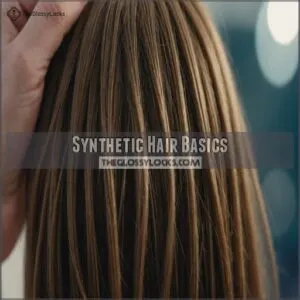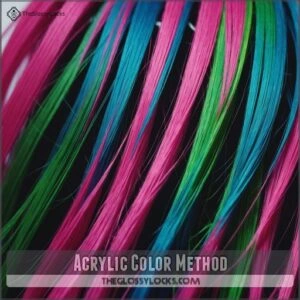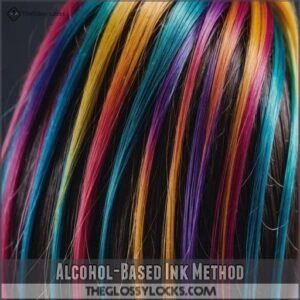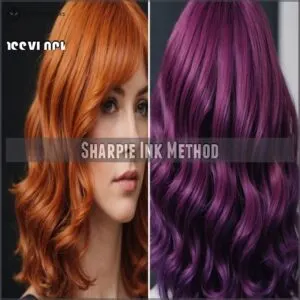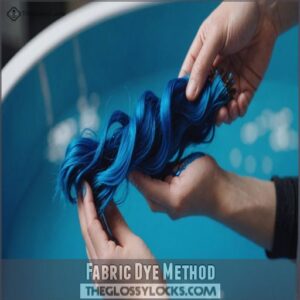This site is supported by our readers. We may earn a commission, at no cost to you, if you purchase through links.
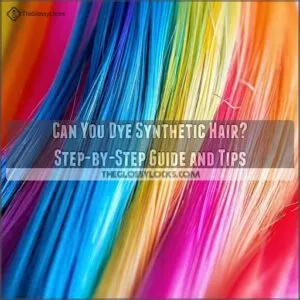 Yes, you can dye synthetic hair, but it requires a bit of creativity.
Yes, you can dye synthetic hair, but it requires a bit of creativity.
Traditional hair dye won’t work, so you’ll need to use alternatives like fabric dye, acrylic paints, or even Sharpies.
Start by washing the hair gently and choosing a light-colored piece for the best results.
Protect your skin and workspace with gloves and aprons because it might get messy.
Experiment with acrylic paint mixed with alcohol for vibrant colors, or try alcohol-based inks.
But remember, always test a small strand first to avoid any surprises.
Ready to go wild with color? There are endless possibilities to explore!
Table Of Contents
- Key Takeaways
- Synthetic Hair Basics
- Preparing Synthetic Hair for Dyeing
- Dyeing Methods and Techniques
- The Dyeing Process and Application
- Safety Measures and Precautions
- Aftercare and Maintenance
- Advanced Techniques and Tips
- Frequently Asked Questions (FAQs)
- Does hair dye damage synthetic hair?
- Can hair dye damage split ends?
- Can You color synthetic hair?
- How do you dye synthetic hair?
- What dye can I use to dye synthetic hair?
- Can you change the color of synthetic hair?
- Can you semi permanently dye synthetic hair?
- Can you dye synthetic hair with acrylic paint?
- How does dye affect hair texture?
- Can I dye synthetic hair more than once?
- Does dyed synthetic hair fade quickly?
- Are there any color restrictions for dyeing?
- Can dyed synthetic hair be washed regularly?
- Conclusion
Key Takeaways
- You can’t use traditional hair dye on synthetic hair. Instead, try alternatives like acrylic paint, Sharpies, or alcohol-based inks for vibrant results.
- For the best results, choose a light-colored synthetic wig with high-quality fibers and ensure proper preparation, like washing and protecting your workspace.
- Experiment with various methods such as the Sharpie ink technique or the fabric dye method to achieve desired colors while following safety precautions.
- After dyeing, handle your synthetic hair with care by avoiding heat styling, using mild shampoos, and opting for air drying to maintain the vibrancy and texture.
Synthetic Hair Basics
You’re probably wondering if synthetic hair can be dyed, and the answer lies in understanding the basics first.
Synthetic hair, made from materials like acrylic and polyester, mimics real hair but doesn’t come with magical coloring powers.
What is Synthetic Hair?
Synthetic hair is basically man-made hair, a fantastic alternative to human hair.
Think of it as a clever imitation, often made from fibers like acrylic or Kanekalon.
It’s super versatile, comes in tons of colors, and is generally cheaper than human hair.
To keep your synthetic hair looking its best and prevent issues like frizz, consider learning more about stop synthetic hair frizzing.
While it mightn’t be as realistic as the real deal, synthetic hair offers incredible styling options and is perfect for experimentation.
Plus, caring for it’s a breeze!
You’ll find plenty of synthetic hair brands available, offering a wide array of choices for your next wig or extension project.
Types of Synthetic Hair Fibers
Exploring synthetic hair fibers is like opening a treasure chest of possibilities.
You’ll find Kanekalon hair, known for its softness and heat resistance, while acrylic fibers are stiff yet vibrant.
For those looking to dye their synthetic wigs, consider checking out dye synthetic wig products to find the right fit.
Nylon fibers add strength but can feel coarse.
Each type offers distinct fiber properties and textures perfect for wigs, hairpieces, and extensions.
Just don’t expect them to dye like human hair!
Quality and Style of Synthetic Hair
Turning from fiber types, let’s chat about synthetic hair’s quality and style.
High-quality pieces mimic real hair closely, adding flair without breaking the bank.
Here’s what you get:
- Durability: Choose heat-resistant fibers to extend wig lifespan.
- Texture: Look for natural-looking hair texture.
- Color Vibrancy: Enjoy vivid hues that don’t fade quickly.
Embrace the possibilities!
Preparing Synthetic Hair for Dyeing
Before you start coloring synthetic hair, make sure it’s ready for the transformation by giving it a good wash with mild shampoo and protecting your work area from potential dye disasters.
Don’t forget to choose a suitable wig—one that’s light in color is your best bet for vibrant results!
Washing and Cleaning The Hair
Before jumping into dyes and colors, washing your synthetic hair is a must.
Use a gentle synthetic hair shampoo to banish dirt and old hair products.
With the right cleaning tools, a quick cleanse helps your wig vibrantly hold color.
Rinse thoroughly, treat it with a light conditioner, and let it air dry to avoid color fading.
Protecting The Work Area and Skin
After washing your synthetic hair, it’s time to safeguard your workspace and yourself.
Nobody enjoys a stained counter—or a stained shirt, for that matter.
If you’re looking for a wide range of synthetic hair color options, check out synthetic hair colors.
Grab gloves and an apron for dye safety.
Cover surfaces with plastic or old newspapers to avoid disaster.
Stain removal isn’t a glamorous part of the coloring process, so protect your surroundings and skin.
Choosing The Right Synthetic Hair for Dyeing
Choosing the right synthetic hair for dyeing requires a bit of finesse and savvy. Aim for a light-colored wig with high-quality fibers to guarantee vibrant results with alternative dyes.
Consider heat-resistant options if styling is on your agenda. Avoid cheap wigs that mightn’t hold color well.
Here’s a quick guide:
- Fiber type matters
- Color choice is key
- Wig style considerations
- Heat resistance adds value
Dyeing Methods and Techniques
Ready to transform your synthetic hair?
You’ll discover several dyeing methods using readily available materials like acrylic paints, alcohol-based inks, or even Sharpies—yes, really!—to achieve your desired shade.
So let’s explore the options!
Alternative Dyes for Synthetic Hair
Got your synthetic hair all prepped and ready? Let’s tackle the colorful world of alternative dyes!
Can you dye synthetic hair using regular dye? Nope!
Instead, think sharpie dyeing for bold looks, or try spray paint methods for quick changes.
For a more natural approach, consider mixing henna with lemon juice for unbleached hair, or explore dyeing pastel hues or natural dye alternatives.
These methods keep your synthetic material vibrant and fresh!
Acrylic Color Method
Exploring alternative dyes, the acrylic color method is a favorite for coloring synthetic hair.
By mixing acrylic paint with rubbing alcohol, you create a vibrant, smooth blend that sticks well to fibers.
Remember to apply evenly and consider safety precautions like wearing gloves.
Don’t rush the drying time; patience will help you achieve the best color blending and a stunning result.
Alcohol-Based Ink Method
As you leave acrylic methods behind, let’s stir things up with alcohol-based ink.
With a 1:1 ink mixing ratio, this technique lets you play with color intensity and enjoy vibrant hues.
It’s all about achieving dye longevity on your alternative hair.
Remember, the right ink brands make all the difference.
Happy dyeing, and watch those colors pop!
Sharpie Ink Method
Let’s move on from alcohol-based inks to an everyday item—Sharpies!
This method is popular for synthetic hair dye in the cosplay community, and you can find a variety of synthetic hair dye products online, such as those at Synthetic Hair Dye Products.
Using Sharpie ink requires caution due to potential safety concerns.
Here’s how to tackle it:
- Dilution: Soak Sharpie ink in alcohol for desired color blending.
- Application: Use gloves for safe dyeing.
- Enjoy: Experiment with ombre effects!
Fabric Dye Method
Imagine transforming your synthetic hair with bold colors using the fabric dye method.
Grab Rit DyeMore, specially made for those synthetic fibers.
Boil some water—yes, like a pasta party—and submerge your wig.
Make sure it’s heat-resistant, or you might end up with a melted mess.
Watch out for safety—gloves and an apron are your new best friends!
The Dyeing Process and Application
When you’re set to color your synthetic hair, mixing the dye properly is essential to get vibrant or subtle hues.
Whether you’re using your fingers or a wide-tooth comb, applying the dye is as easy as painting by numbers, but without the stress of coloring inside the lines.
Mixing The Dye
A key first step is mastering the dye ratios.
For a bold, opaque color, mix your alcohol-based ink with water, aiming for a 1:1 ratio.
Want a softer, pastel shade? Thin it out—think eight cups of water to one part ink!
Remember, water quality matters; use clean water for best results.
Experiment with color blending to achieve your desired vfx color effects.
Don’t be afraid to get creative!
Achieve the perfect mixing consistency for even application.
Applying The Dye to The Hair
Start by sectioning the hair into manageable parts, making your dyeing adventure less of a tangled mess.
With your trusty dye in hand, aim for an even application. Use fingers to make sure the color soaks in thoroughly, but don’t overdo it, or you’ll risk dye overload.
Pop on a plastic bag for extra pizzazz and let it set.
Combining Through The Hair
Achieving dyeing evenness in synthetic hair can feel like an art.
Use a wide-tooth comb to blend colors smoothly.
Remember:
- Comb type: Opt for wide-tooth.
- Section size: Keep sections 2-3 inches.
- Dye distribution: Make sure you cover the hair fully from root to tip.
- Color blending: Sweep the dye to create harmony.
Your hair masterpiece awaits!
Using a Plastic Bag to Dye The Wig
After ensuring the dye is combed evenly, grab a large plastic bag for submersion.
This trick guarantees uniform color saturation by immersing your wig fully in the dye bath.
Time estimation depends on your desired shade, so keep an eye out.
Think of it as marinating, but instead of steak, it’s your wig absorbing rich hues.
Safety Measures and Precautions
Before you become the Picasso of synthetic hair, remember that safety isn’t just a boring checklist but a vital first step.
Don’t forget your trusty gloves and apron to avoid mishaps—no one wants a surprise hair color on their favorite shirt!
Wearing Protective Gear
Dyeing synthetic hair can be a colorful adventure, but don’t forget safety gear!
Slip on gloves and an apron to keep stains at bay.
Shield your eyes with protection and wear a face mask, breathing easy while crafting your new look.
Remember, even your work surface needs a little love, so protect it from splashes and spills!
- Gloves
- Apron
- Eye Protection
- Face Mask
Avoiding Damage to The Hair
Got your protective gear on? Great! Now, let’s make sure that synthetic hair stays silky. Avoid over-washing, which can lead to color fading. Be careful with heat styling; keep those temperatures low to prevent frazzling. Fabric dye can be tricky; handle with care. Remember, less is more when handling synthetic fibers.
| Safety Tip | Reminder |
|---|---|
| Heat styling | Use lowest setting |
| Over-washing | Wash sparingly |
| Fabric dye use | Make sure it’s compatible |
| Color fading | Rinse with cool water |
| Protective care | Keep handling gentle |
Doing a Strand Test
A key first step? A strand test!
This helps you check dye color impact and fiber compatibility before committing to a full dye job.
It’s like a tiny preview, ensuring your chosen dye application techniques won’t cause a synthetic hair catastrophe.
Observe the strand test results carefully; this simple safety precaution could save your wig!
Aftercare and Maintenance
Now that your synthetic masterpiece is boldly colored, let’s chat about keeping it fabulous.
You wouldn’t wash your new Ferrari with dish soap, which can be too harsh even for removing unwanted purple toner from hair using clarifying shampoo methods, right?
So drying, rinsing, and conditioning that freshly dyed wig requires specific love and care to make sure it stays as stunning as the day you dyed it.
Drying and Rinsing The Hair
Finish up by gently rinsing your fabulous creation until the water runs clear, making sure every bit of excess dye is gone.
Now, resist the urge to grab that hairdryer! Instead, let your synthetic masterpiece air dry naturally. It helps prevent color fade and keeps those fibers in tip-top shape.
Remember, patience here guarantees your wig maintains its vibrant charm!
Detangling and Conditioning The Hair
After dyeing, it’s time to tackle those tangles!
Use a wide-tooth comb, starting from the tips, to ease out knots—it’s like a mini spa session for your hair.
Follow up with the best synthetic hair conditioner to keep strands smooth and vibrant.
Remember, preventing tangles is key, so a good detangling tool is your hair’s best friend!
Avoiding Heat Styling Tools
You’re likely careful with your synthetic wig, so it’s good to know that using fabric softener can reduce frizz and tangles when washing it, check out tips on how to wash with fabric softener. Skip the heat styling tools. Try these tricks instead for fabulous looks:
- Cold styling protects your wig.
- Roll and pin it for heatless curls.
- Allow nature to work with air drying.
- Use a spritz bottle to tame flyaways as a styling option.
- Show your wig some love with gentle wig care.
Advanced Techniques and Tips
Ready to take your synthetic hair dyeing skills to the next level?
This section explores advanced techniques, like creating ombre effects or dyeing only specific sections, so you can achieve truly unique and stylish looks.
Using Different Dyes for Unique Colors
Exploring unique colors in synthetic hair offers exciting dyeing techniques to explore your creativity.
Combine alcohol-based inks for vibrant hues or mix acrylic paints for pastel shades.
Keep in mind that, when dyeing human hair, using hair dye without a developer can result in undesired color and uneven distribution, as seen in dyeing hair without developer.
Feel adventurous? Try fabric dyes for intriguing results.
Remember, synthetic hair can’t be lightened, so start with a lighter wig for bold transformations.
Just experiment and enjoy discovering a world of color possibilities!
Creating Ombre and Gradient Effects
Jumping from experimenting with unique dyes, you can craft stunning ombre and gradient effects on synthetic hair.
Start by selecting a color palette that suits your style, focusing on smooth color blending.
Use gradient tools or fade techniques to achieve that subtle color shift, giving your hair a trendy, artsy look.
Remember, practice makes perfect with these dyeing tips!
Dyeing Specific Sections of The Hair
Ever been wary of messing up with bold hair choices?
Don’t fret!
Try dyeing specific sections for highlights or a balayage effect—perfect for creativity without a full commitment.
Consider color blocking for dramatic flair or subtle ombre for class.
Test each section carefully, and remember, dip dye can add just the right pop.
Let your imagination soar!
Frequently Asked Questions (FAQs)
Does hair dye damage synthetic hair?
Picture synthetic hair’s glossy surface meeting harsh chemicals.
Regular hair dyes pack a punch with ammonia and peroxide, which can harm synthetic strands.
Instead, opt for gentler alternatives like alcohol-based or fabric dyes to protect those fibers.
Can hair dye damage split ends?
No, hair dye won’t magically fix split ends.
It’ll just color them.
To truly conquer those pesky splits, you’ll need a trim.
Think of it as a fresh start for your hair!
Can You color synthetic hair?
You can color synthetic hair, but you can’t use regular hair dye.
Opt for alcohol-based inks or fabric dyes like Rit DyeMore, and follow the right techniques for vibrant results.
It’s a fun, creative process!
How do you dye synthetic hair?
Imagine transforming a canvas into a vibrant masterpiece with safety in mind.
To dye synthetic hair, use alcohol-based ink or acrylic paint, apply with precision, and let it dry.
Always protect your space and skin.
What dye can I use to dye synthetic hair?
Opt for alcohol-based inks, sharpie markers, acrylic colors, or fabric dyes like Rit DyeMore.
Some hair care products use trisiloxane for its water-repellent properties and silky texture, while others explore alternatives for curly hair hydration. These alternatives can tint synthetic hair effectively.
Just remember, traditional hair dyes may not work due to the synthetic material’s unique properties, much like how expired hair dye can lack potency and won’t produce desired results, as seen with color absorption issues. Traditional hair dyes won’t work due to the synthetic material’s unique properties.
Can you change the color of synthetic hair?
Changing synthetic hair’s color requires special methods.
You can use alcohol-based or acrylic dyes, but regular hair dye won’t work due to synthetic fibers’ nature.
Choose these alternatives and follow proper steps to guarantee vibrant results!
Can you semi permanently dye synthetic hair?
You can’t use traditional semi-permanent dyes on synthetic hair.
But with specialized products like alcohol-based inks or fabric dyes like Rit DyeMore, you can achieve semi-permanent results.
These products ensure vibrant, lasting color on synthetic fibers.
Can you dye synthetic hair with acrylic paint?
Imagine this: acrylic paint can transform synthetic hair into a masterpiece!
Mix it with some rubbing alcohol to create a vibrant dye.
Just remember, using a brush, apply evenly for the best look.
Have fun!
How does dye affect hair texture?
Dyeing can slightly alter hair texture, sometimes making it drier or rougher. However, proper conditioners and gentle handling can minimize this effect. It’s all about finding the right balance!
Can I dye synthetic hair more than once?
It’s worth noting that dyeing synthetic hair isn’t a one-time wonder.
You can dye it again if it’s heat-resistant and high-quality.
Just watch out: too many dye jobs might turn your once-vibrant locks into a tangled mess!
Does dyed synthetic hair fade quickly?
Yes, dyed synthetic hair tends to fade faster than human hair.
The color gradually loses vibrancy, especially with frequent washing or exposure to sunlight.
Use color-protecting products and wash less often to prolong its look.
Are there any color restrictions for dyeing?
You’re thinking about dyeing synthetic hair, right?
Don’t worry, but stick to darker shades since synthetic hair can’t be lightened.
Using only methods like acrylic or alcohol-based ink keeps it looking vibrant and damage-free.
Can dyed synthetic hair be washed regularly?
Sure, you can wash dyed synthetic hair, but be gentle!
Use a mild shampoo made for synthetic fibers.
Avoid hot water.
Skip the rough scrubbing.
To preserve the vibrant color of your synthetic hair, especially if it’s blue, consider using a color-maintenance product like purple shampoo for blue hair. You’ll want to preserve its vibrant color and texture.
Conclusion
About 90% of people who’ve tried dyeing synthetic hair felt creative satisfaction.
If you’re wondering, "can you dye synthetic hair?" the answer is a resounding yes.
With the right preparation and methods like acrylic, alcohol-based, or fabric dyes, you can transform your synthetic wig into something unique.
Just remember to test a strand first, and take care with aftercare like avoiding heat tools.
Go ahead and have fun exploring the endless colors and styles you can achieve!

